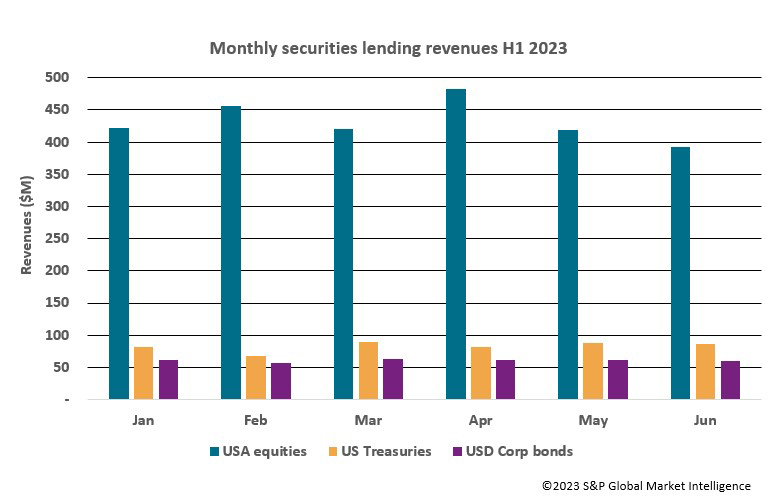US equities have been the powerhouse for near-record securities lending revenues during the first half of 2023. S&P Global Market Intelligence’s Matthew Chessum explains why, amid considerable economic uncertainty, US lending markets have remained highly robust
The first half of 2023 recorded the second-highest half year securities lending revenues to date, raising US$7.020 billion, US$5.394 billion of which was generated through equities lending. During the first six months of the year — as during the past 18 months in particular — lending of US equities has been an important contributor to these overall revenue numbers, accounting for 48 per cent of H1 equity revenues.
The US economy has experienced a very eventful 18 months. It has experienced everything from banking collapses, artificial intelligence mania, a narrow equity rally — which has started to broaden out — a potential US debt ceiling cliff edge and a predicted, but never materialising, recession. Despite all of this uncertainty, securities lending markets in the US have remained remarkably robust.
Uncertainty can sometimes be a double-edged sword for the securities lending markets as confidence and conviction remains key to ensuring that the conditions remain optimal for trade execution. If these precise conditions do not exist, then investors tend to sit on the sidelines awaiting market signals that strengthen conviction and momentum. Luckily, for both lenders and borrowers, market conditions were ripe for a bumper H1, especially in the US.
Over the six-month period, the lending of US equities generated an impressive US$2.592 billion, driven by US$1.298 billion in Q1 and US$1.294 billion in Q2. This represents an increase of 28 per cent YoY, rising from US$2.029 billion generated in H1 2022. Examining these trends on a month-by-month basis, there were three stand out months for US equities during H1. January revenues of US$421.8 million represent a year-on-year increase of 84 per cent. February revenues were up 64 per cent YoY to US$456.9 million; and the US$481.9 million raised during April represented a 44 per cent increase YoY (fig 1).
Over the six-month period, June was the only month that did not exceed the previous year’s revenues, with revenue contracting 16 per cent YoY to US$393.0 million. The average increase in revenues over the period was an impressive 35 per cent YoY.
Vibrant specials market
The momentum provided by the numerous market events that took place throughout H1 helped to cultivate an exceptionally healthy specials market in the US. At S&P Global Market intelligence, the specials market refers to loans of a security at a fee greater than 500bps.
US equity specials generated US$2.049 billion in revenues over the first six months of the year. To put this in context, this represents a 44 per cent increase on the US$1.4 billion generated in H1 2022 and also an improvement on the US$1.290 billion raised in H1 2021 and US$1.185 billion in H1 2020. Over the course of H1, April was the strongest month for US equities specials revenue, returning just under US$393 million. During this month, 77 per cent of all US equity revenues were generated by specials trading.
Over the six-month period, an average of 78 per cent of all monthly revenues was generated by specials, accounting for 3.2 per cent of all balances. As long as any recall risk is managed effectively, this market has been very good at producing exceptionally strong risk-adjusted returns for lenders.
Fig 1: Monthly securities lending revenues for US assets for H1 2023

During H1, all of the 10 highest-generating equities across all regions were US-listed assets. AMC outpaced all of the other names, generating in excess of the US$450 million alone. Significantly, AMC generated more than the next four highest revenue generating names combined (Beyond Meat, BYND, at US$126.63 million; Lucid Group, LCID, at US$116.71 million; Upstart Holdings, UPST, at US$93.38 million; and Gamestop Corp, GME, at US$76.96 million) over the H1 period.
US equities have dominated the top revenue earning tables for many quarters. As markets continue to climb in the region and valuations reach levels not seen for many months, it is likely that this will continue going forward. The strength of the stock market, coupled with higher valuations, is also likely to provide fertile ground for the re-emergence of initial public offerings (IPOs) and an increase in corporate activity heading into Q3 and Q4. This is likely to drive up volumes in the securities lending markets as investors look to source liquidity and exploit any pricing differentials that may be generated from a change in corporate structures.
Fixed income markets
Across the fixed income markets, both USD-denominated corporate debt and US treasuries also experienced a fruitful H1. Over the six-month period, the lending of US treasuries generated US$493.6 million, representing an enormous 202 per cent increase YoY.
Revenues surpassed US$80 million during every month in H1 apart from February, which generated US$67.5 million. US treasuries experienced strong demand over H1 due to persistent interest rate hikes by the Fed and the uncertainty experienced by the ongoing discussions regarding the US debt ceiling. Over the period, T-Bills expiring towards the X-date traded special — the date at which the US treasury would potentially run out of money to pay its bills — helping to boost revenues. Short-dated treasuries remained popular, dominating the highest revenue-generating government bond tables over both Q1 and Q2.
In the corporate bond markets, lending of USD-denominated investment grade and non-investment grade corporate bonds soared. Revenues reached US$363.7 million over H1, which represented an increase of 123 per cent YoY. Q1 saw revenues grow by 146 per cent YoY to US$180.8 million and revenues rose during Q2 by 104 per cent to US$182.9 million.
Despite the increase in revenues, average fees were lower during every month of H1, standing at an average of 47bps over the six-month period. Balances significantly increased YoY, however, which helped to push revenues higher, resulting in an average YoY increase of 197 per cent per month during H1. Corporate bonds continued to be affected by changes in treasury yields, a lack of market liquidity, and some specials activity linked to refinancing and company news.
The latest World Flash report, produced by S&P Global Market Intelligence, suggests that the leading indicators that remain consistent with an expansionary narrative are starting to lose momentum. This is the case, despite resilient US economic data and a disinflationary trend within the US economy. US hiking cycles appear to have further to go as persistent inflation and resilience in labour markets are likely to compel the Fed to continue to tighten policy until it is convinced that inflation is back on target.
The report also concludes that recent disinflationary readings on US consumer data and producer prices are likely to be insufficient to sway policymakers from making two more 25bps hikes during 2023. While consensus surrounding a soft landing for the US economy does appear to be gathering steam, this is not a forgone conclusion. Further uncertainty is likely to offer additional opportunities for both borrowers and lenders in the US. Securities lending revenues remain resilient and strong, however, and currently point towards all-time highs as we head into H2.


